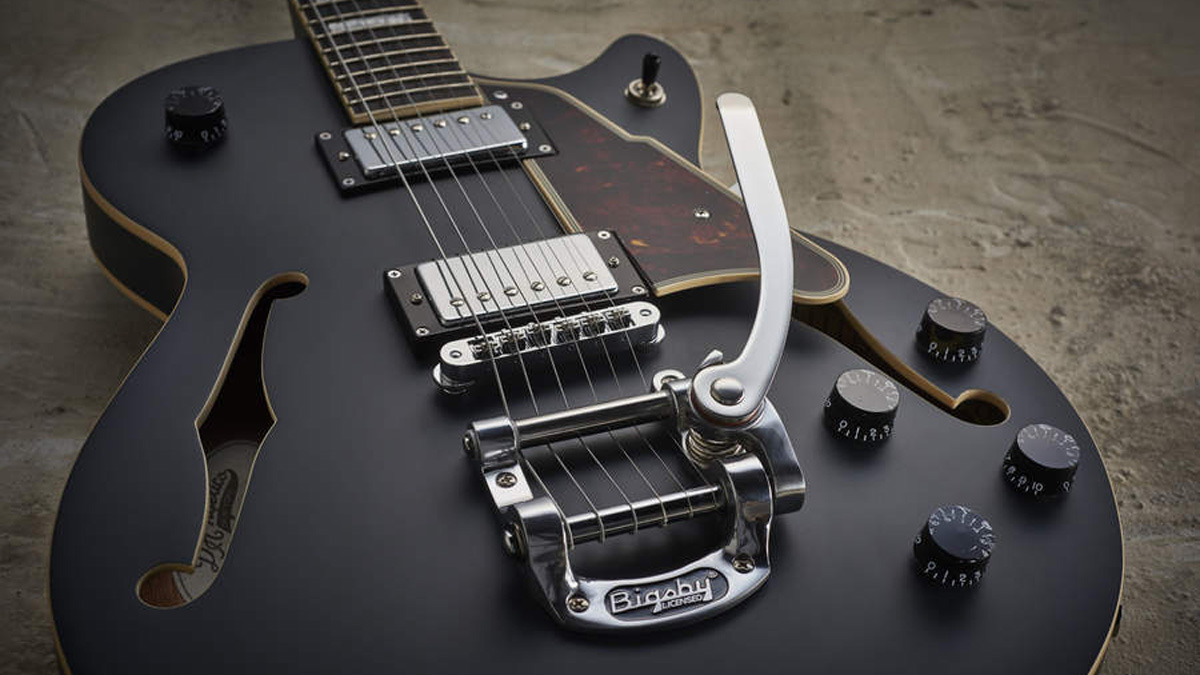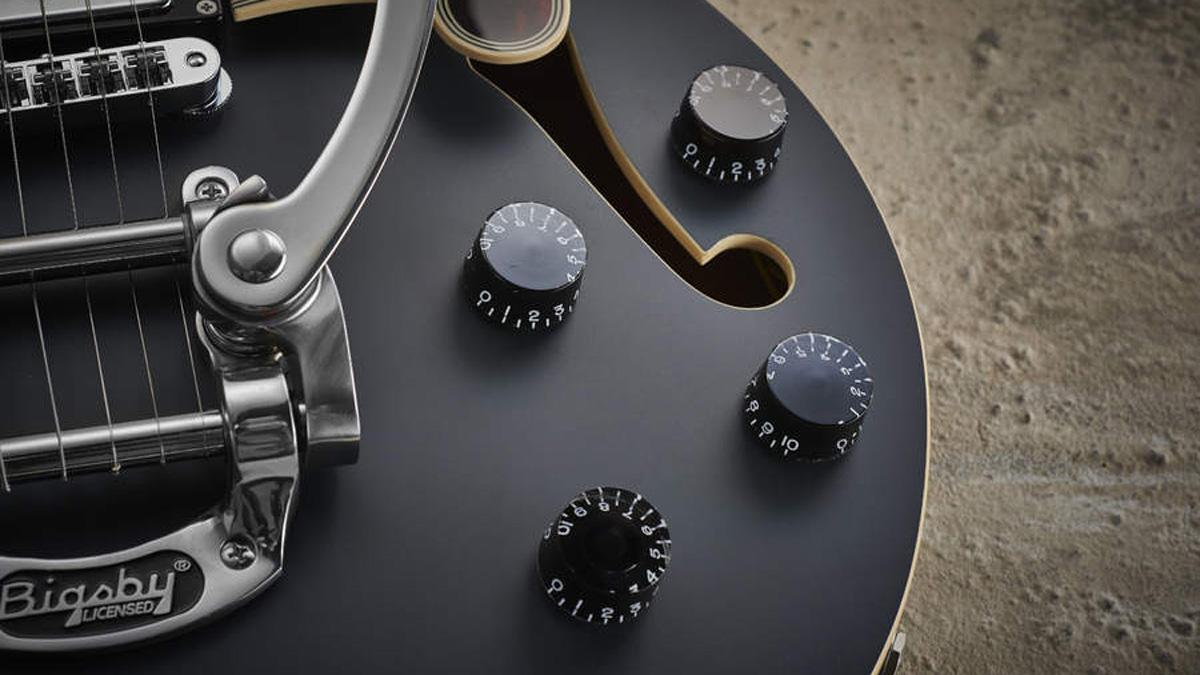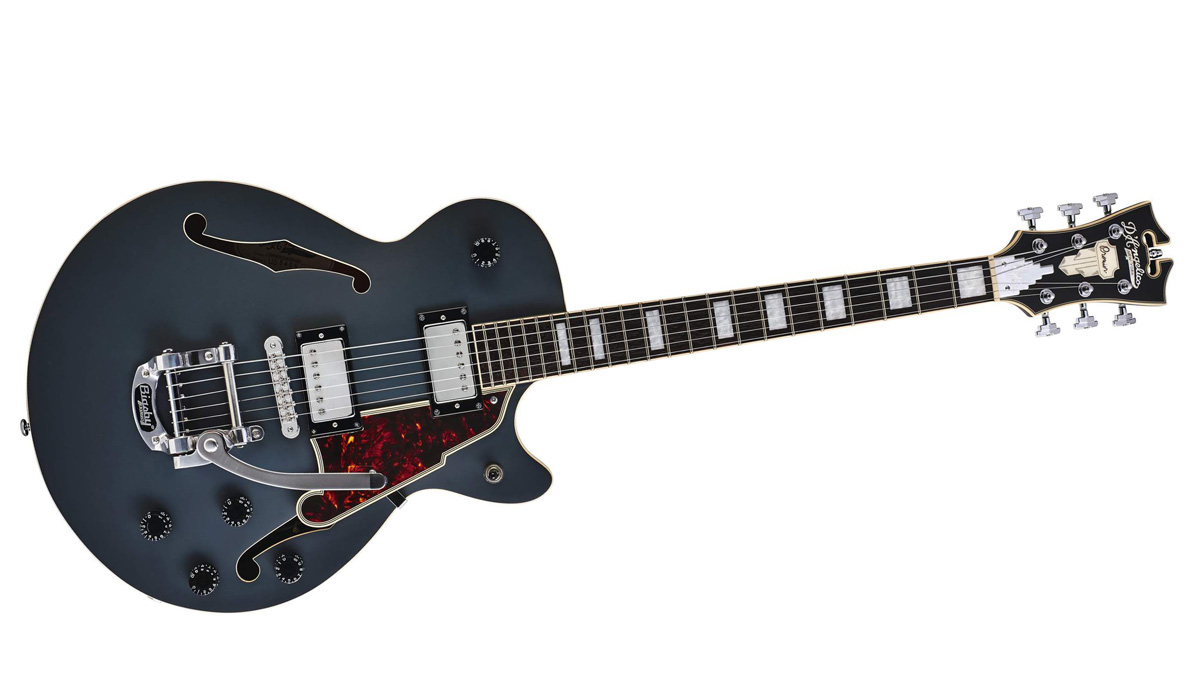MusicRadar Verdict
Sniff out the right deal and you might just snap up a Bob Weir SS in a New York minute.
Pros
- +
There’s no denying it’s a pretty guitar but it’s the feel and tone that’ll keep you coming back.
Cons
- -
Stuff like the OEM pickups, plastic top nut and import Bigsby make it feel overpriced.
MusicRadar's got your back
Say you had to come up with a good-looking retro guitar design, then you could do worse than bolt on some Art Deco-inspired bits and pieces.
It’s an approach that has worked well for the likes of Reverend, Italia and, of course, Duesenberg and D’Angelico.
The difference between D’Angelico and the rest of those guys is that the brand was actually born in New York City in 1932, a place and time where Art Deco was a living, breathing thing. In fact, the ultimate expressions of Deco decadence, the Empire State and Chrysler buildings, were only a year and two years old respectively when jazz archtop godfather John D’Angelico broke ground on his workshop at 40 Kenmare Street in Manhattan’s Little Italy.
D’Angelico built 1,164 instruments before his death in 1964, and while his hollow-body archtop jazz guitars are regarded as some of the finest ever made, the Bob Weir SS model that has fallen into our clutches is a slim-bodied semi-acoustic.
It belongs to D’Angelico’s entry-level Premier range, and is semi-hollow like your classic Gibson ES-335, with a big timber centre-block adding weight to the laminated maple carcass. It has 44mm deep sides and measures 406mm across the widest point of its body.
The glued-in neck is hewn from maple and it features slim C profile, rosewood ’board, block inlay and 22 medium jumbo frets. The top nuts are crafted from finest PPS. That’s plastic to you.
Now, before we go any further, we should address this Bob Weir we keep name-checking. Bob is best known as a founder member of 60s cosmic-jam band, Grateful Dead. The Sex Pistols warned never to trust a hippy but D’Angelico has given Bob carte blanche to spec his new signature guitar.

You may recall this isn’t Bob’s first rodeo. In 1974, Weir worked with Ibanez to develop the 2681 model, the now sought-after Artist Series guitar with a German-carved solidbody and a pre-Vai ‘tree-of-life’ fingerboard inlay. The 2681 was an important milestone for Ibanez, not least as it helped shatter its image as another band of Japanese copycats at the height of the ‘lawsuit era’.
Pretty as it is, Bob’s new D’Angelico SS is much less groundbreaking. You get two servings of the house ‘Dual Coil’ pickups, aka humbuckers, and a wiring loom consisting of two volumes, two tones and a three-way pickup selector toggle. What you might not expect is the Gretsch-style master volume, within easy reach on the guitar’s upper bout, and a push/pull coil split for each ’bucker on the tone controls.
Hardware is covered by an anchored tune-o-matic bridge and a licensed Bigsby B50 vibrato. It’s the import version of the classic B5 ‘horseshoe’ Bigsby - you can tell this isn’t a US item because of the added zero on the model designation, and the fact it has ‘licensed’ cast into it. The bridge also has six roller saddles to aid tuning stability - reducing string drag is always a good thing.
Bob’s guitar comes in a Matt Stone finish. That might sound like a private eye, but this paint is described by D’Angelico as a “rich grey-black that sits somewhere between smoke and a rain cloud”. Hippies, eh?
Before we set about plugging in, let’s tie up some loose ends. The SS comes with a big headstock emblazoned with beautiful mother-of-pearl D’Angelico logos and an Art Deco Premier shield. It might say ‘New York’ on the logo but the price tags should be a clue that this guitar wasn’t born in the Big Apple. Indeed, an unsightly sticker on the reverse of the headstock reveals the truth. Production has migrated from Little Italy to Indonesia.
Sounds
Straight from the included padded gigbag, the guitar plays well with a medium to low action. The SS feels light hanging from a strap at 3.2kg.
The SS’s power is subtle, we reckon we can detect some bottom-end snap due to the scale length. Tuning stability is good too, even if you give the Bigsby a decent workout.
The coil splits drop the output of each ’bucker in single-coil mode but what’s interesting is how little the tonality changes. Almost to the point of the coil splits being surplus to requirements. There’s still a good amount of bottom-end grunt in the single coil tones.
What you do gain when you drop to single coils is some extra clarity on filthier tones, especially when you’re noodling through some overdrive-fuelled blues clichés on the neck pickup. Back off the volume a touch and you’re almost in Fender territory. This guitar is tonally versatile, then...

Old hippies never die, they just get offered their own signature guitars. And we do like Bob’s take on the D’Angelico SS. The Grateful Dead were famous for playing epic jams, and the SS feels like it could handle it. It plays, sounds and looks great. Of course, Deadheads might be drawn to it because of its pedigree. Meanwhile, the rest of us might take issue with the price.
As pretty as it is, the Bob Weir SS is a bit too close to a grand for our liking. It faces some competition in the semi-acoustic sector, not least from Epiphone with its well-built and lower-priced ES-335 Dot and Sheraton II models.
That all said and done, if you’re looking for a good quality semi-acoustic, you’ll want to consider as many options as possible. That means you need to have this guitar on your ‘must try’ list.
“I have an original 909 – every time I try to use it I feel like I’m ruining it”: House hero Riva Starr on his studio essentials and his love of analogue synths
“A synthesizer that is both easy to use and fun to play whilst maintaining a decent degree of programming depth and flexibility”: PWM Mantis review
“I feel like that song had everything we needed to come back with”: Bring Me The Horizon’s Lee Malia on Shadow Moses, its riff and the secrets behind its tone, and why it was the right anthem at the right time










